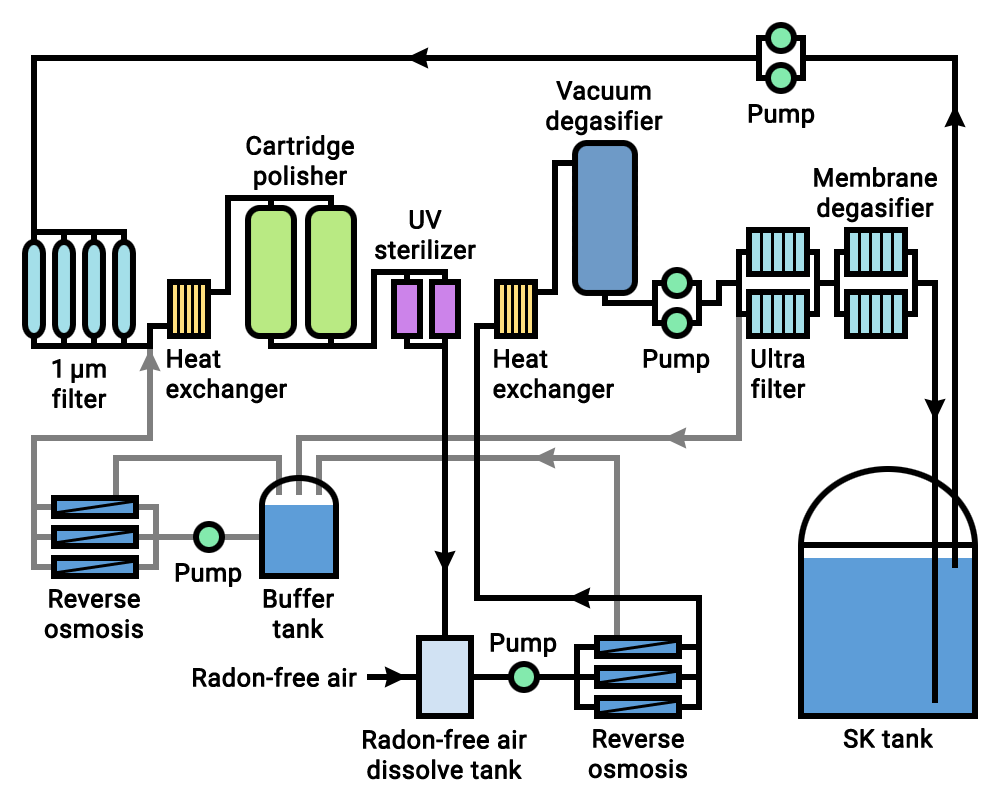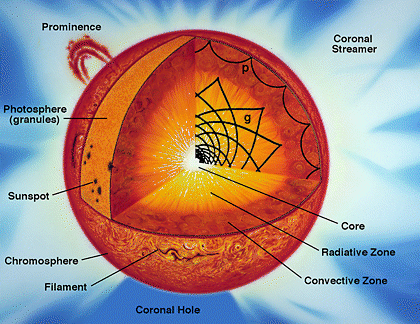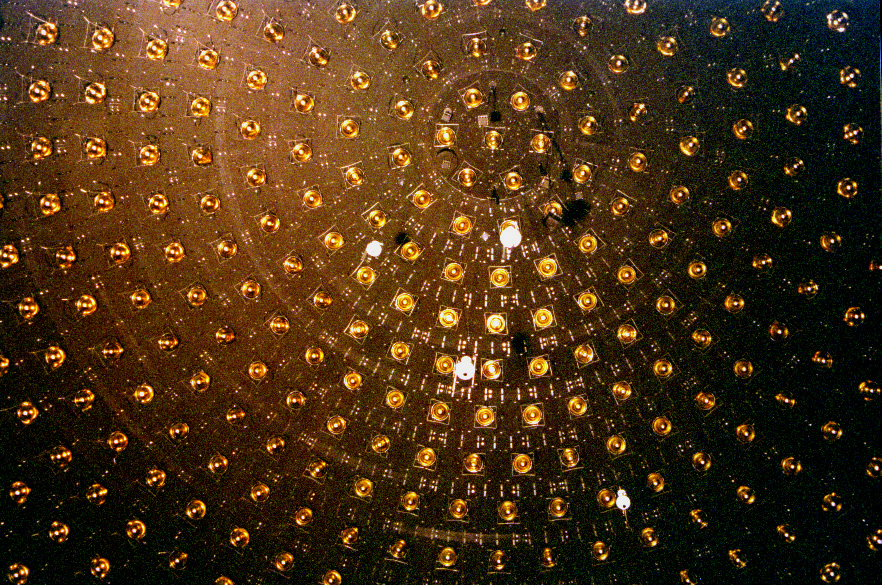|
Super-Kamiokande
Super-Kamiokande (abbreviation of Super-Kamioka Neutrino Detection Experiment, also abbreviated to Super-K or SK; ja, スーパーカミオカンデ) is a neutrino observatory located under Mount Ikeno near the city of Hida, Gifu Prefecture, Japan. It is located underground in the Mozumi Mine in Hida's Kamioka area. The observatory was designed to detect high-energy neutrinos, to search for proton decay, study solar and atmospheric neutrinos, and keep watch for supernovae in the Milky Way Galaxy. It consists of a cylindrical stainless steel tank about in height and diameter holding 50,000 metric tons (55,000 US tons) of ultrapure water. Mounted on an inside superstructure are about 13,000 photomultiplier tubes that detect light from Cherenkov radiation. A neutrino interaction with the electrons or nuclei of water can produce an electron or positron that moves faster than the speed of light in water, which is slower than the speed of light in a vacuum. This creates a ... [...More Info...] [...Related Items...] OR: [Wikipedia] [Google] [Baidu] |
Solar Neutrino
A solar neutrino is a neutrino originating from nuclear fusion in the Sun's core, and is the most common type of neutrino passing through any source observed on Earth at any particular moment. Neutrinos are elementary particles with extremely small rest mass and a neutral electric charge. They only interact with matter via the weak interaction and gravity, making their detection very difficult. This has led to the now-resolved solar neutrino problem. Much is now known about solar neutrinos, but the research in this field is ongoing. History and background Homestake experiment The timeline of solar neutrinos and their discovery dates back to the 1960s, beginning with the two astrophysicists John N. Bahcall and Raymond Davis Jr. The experiment, known as the Homestake experiment, named after the town in which it was conducted (Homestake, South Dakota), aimed to count the solar neutrinos arriving at Earth. Bahcall, using a solar model he developed, came to the conclusion that ... [...More Info...] [...Related Items...] OR: [Wikipedia] [Google] [Baidu] |
Kamioka Observatory
The is a neutrino and gravitational waves laboratory located underground in the Mozumi mine of the Kamioka Mining and Smelting Co. near the Kamioka section of the city of Hida in Gifu Prefecture, Japan. A set of groundbreaking neutrino experiments have taken place at the observatory over the past two decades. All of the experiments have been very large and have contributed substantially to the advancement of particle physics, in particular to the study of neutrino astronomy and neutrino oscillation. The mine The Mozumi mine is one of two adjacent mines owned by the Kamioka Mining and Smelting Co. (a subsidiary of the Mitsui Mining and Smelting Co. Mitsui Kinzoku'). The mine is famous as the site of one of the greatest mass-poisonings in Japanese history. From 1910 to 1945, the mine operators released cadmium from the processing plant into the local water. This cadmium caused what the locals called itai-itai disease. The disease caused weakening of the bones and extreme pain. ... [...More Info...] [...Related Items...] OR: [Wikipedia] [Google] [Baidu] |
Supernova Neutrinos
Supernova neutrinos are weakly interactive elementary particles produced during a core-collapse supernova explosion. A massive star collapses at the end of its life, emitting of the order of 1058 neutrinos and antineutrinos in all lepton flavors. The luminosity of different neutrino and antineutrino species are roughly the same. They carry away about 99% of the gravitational energy of the dying star as a burst lasting tens of seconds. The typical supernova neutrino energies are 10–20 MeV. Supernovae are considered the strongest and most frequent source of cosmic neutrinos in the MeV energy range. Since neutrinos are generated in the core of a supernova, they play a crucial role in the star's collapse and explosion. Neutrino heating is believed to be a critical factor in supernova explosions. Therefore, observation of neutrinos from supernova provides detailed information about core collapse and the explosion mechanism. Further, neutrinos undergoing collective flavor conv ... [...More Info...] [...Related Items...] OR: [Wikipedia] [Google] [Baidu] |
Proton Decay
In particle physics, proton decay is a hypothetical form of particle decay in which the proton decays into lighter subatomic particles, such as a neutral pion and a positron. The proton decay hypothesis was first formulated by Andrei Sakharov in 1967. Despite significant experimental effort, proton decay has never been observed. If it does decay via a positron, the proton's half-life is constrained to be at least years. According to the Standard Model, the proton, a type of baryon, is stable because baryon number (quark number) is conserved (under normal circumstances; see chiral anomaly for an exception). Therefore, protons will not decay into other particles on their own, because they are the lightest (and therefore least energetic) baryon. Positron emission and electron capture – forms of radioactive decay which sees a proton become a neutron – are not proton decay, since the proton interacts with other particles within the atom. Some beyond-the-Standard Model gran ... [...More Info...] [...Related Items...] OR: [Wikipedia] [Google] [Baidu] |
Neutrino
A neutrino ( ; denoted by the Greek letter ) is a fermion (an elementary particle with spin of ) that interacts only via the weak interaction and gravity. The neutrino is so named because it is electrically neutral and because its rest mass is so small ('' -ino'') that it was long thought to be zero. The rest mass of the neutrino is much smaller than that of the other known elementary particles excluding massless particles. The weak force has a very short range, the gravitational interaction is extremely weak due to the very small mass of the neutrino, and neutrinos do not participate in the strong interaction. Thus, neutrinos typically pass through normal matter unimpeded and undetected. Weak interactions create neutrinos in one of three leptonic flavors: electron neutrinos muon neutrinos (), or tau neutrinos (), in association with the corresponding charged lepton. Although neutrinos were long believed to be massless, it is now known that there are three discrete ... [...More Info...] [...Related Items...] OR: [Wikipedia] [Google] [Baidu] |
Gifu Prefecture
is a prefecture of Japan located in the Chūbu region of Honshu. Gifu Prefecture has a population of 1,991,390 () and has a geographic area of . Gifu Prefecture borders Toyama Prefecture to the north; Ishikawa Prefecture to the northwest, Fukui Prefecture and Shiga Prefecture to the west, Mie Prefecture to the southwest, Aichi Prefecture to the south, and Nagano Prefecture to the east. Gifu is the capital and largest city of Gifu Prefecture, with other major cities including Ōgaki, Kakamigahara, and Tajimi. Gifu Prefecture is located in the center of Japan, one of only eight landlocked prefectures, and features the country's center of population. Gifu Prefecture has served as the historic crossroads of Japan with routes connecting the east to the west, including the Nakasendō, one of the Five Routes of the Edo period. Gifu Prefecture was a long-term residence of Oda Nobunaga and Saitō Dōsan, two influential figures of Japanese history in the Sengoku period, spawning ... [...More Info...] [...Related Items...] OR: [Wikipedia] [Google] [Baidu] |
Neutrino Detector
A neutrino detector is a physics apparatus which is designed to study neutrinos. Because neutrinos only Weak interaction, weakly interact with other particles of matter, neutrino detectors must be very large to detect a significant number of neutrinos. Neutrino detectors are often built underground, to isolate the detector from cosmic rays and other background radiation. The field of neutrino astronomy is still very much in its infancy – the only confirmed extraterrestrial sources are the Sun and the SN 1987A, supernova 1987A in the nearby Large Magellanic Cloud. Another likely source (three standard deviations) is the blazar TXS 0506+056 about 3.7 billion light years away. Neutrino observatories will "give astronomers fresh eyes with which to study the universe". Various detection methods have been used. Super Kamiokande is a large volume of water surrounded by phototubes that watch for the Cherenkov radiation emitted when an incoming neutrino creates an electron or muon ... [...More Info...] [...Related Items...] OR: [Wikipedia] [Google] [Baidu] |
Hida, Gifu
is a city located in Gifu, Japan. , the city had an estimated population of 24,726, and a population density of 31 persons per km2, in 8,905 households. The total area of the city was . The official ''kanji'' for the city is actually 飛驒, which uses the old rendering of the 騨 character. However, the 驒 characters is not included on the official list of usable characters (as decided by the Ministry of Internal Affairs and Communications), so the 騨 character is often used outside of the city. Geography Hida is the northernmost city in Gifu Prefecture, and is located in the northern part of the Hida Highlands bordering on Toyama Prefecture to the north. The majority of the area of the city is forested, with many mountains exceeding 1,000 meters within the city borders. The northeastern edge of the Hida Mountain range exceeds 2,000 meters. Most of the population is concentrated along river terraces along the Jinzū River and the Takahara River. Climate The city has a clim ... [...More Info...] [...Related Items...] OR: [Wikipedia] [Google] [Baidu] |
Institute For Cosmic Ray Research
The Institute for Cosmic Ray Research (ICRR) of the University of Tokyo (東京大学宇宙線研究所 ''Tōkyōdaigaku Uchūsen Kenkyūsho'') was established in 1976 for the study of cosmic rays. The gravitational wave studies group is currently constructing the detector KAGRA located at the Kamioka Observatory. Facilities * Kashiwa Campus at the University of Tokyo * Akeno Observatory * Kamioka Observatory * Norikura Observatory Current projects *Super-Kamiokande - Detection of neutrinos and search for proton decays in a large water tank *Tibet - Search for point sources of VHE cosmic gamma rays at Tibet heights *Telescope Array Project - Aiming at highest energy cosmic ray physics by detecting weak light from atmosphere"New Ground-Based Arrays to Probe Cosmic Powerhouses" By Dennis Normile Science 30 April 1999: 734-735 *Gravitational Wave Group - Constructing the gravitational wave detector KAGRA The Kamioka Gravitational Wave Detector (KAGRA), is a large interferometer de ... [...More Info...] [...Related Items...] OR: [Wikipedia] [Google] [Baidu] |
Muon
A muon ( ; from the Greek letter mu (μ) used to represent it) is an elementary particle similar to the electron, with an electric charge of −1 '' e'' and a spin of , but with a much greater mass. It is classified as a lepton. As with other leptons, the muon is not thought to be composed of any simpler particles; that is, it is a fundamental particle. The muon is an unstable subatomic particle with a mean lifetime of , much longer than many other subatomic particles. As with the decay of the non-elementary neutron (with a lifetime around 15 minutes), muon decay is slow (by subatomic standards) because the decay is mediated only by the weak interaction (rather than the more powerful strong interaction or electromagnetic interaction), and because the mass difference between the muon and the set of its decay products is small, providing few kinetic degrees of freedom for decay. Muon decay almost always produces at least three particles, which must include an electron o ... [...More Info...] [...Related Items...] OR: [Wikipedia] [Google] [Baidu] |
Scattering
Scattering is a term used in physics to describe a wide range of physical processes where moving particles or radiation of some form, such as light or sound, are forced to deviate from a straight trajectory by localized non-uniformities (including particles and radiation) in the medium through which they pass. In conventional use, this also includes deviation of reflected radiation from the angle predicted by the law of reflection. Reflections of radiation that undergo scattering are often called ''diffuse reflections'' and unscattered reflections are called ''specular'' (mirror-like) reflections. Originally, the term was confined to light scattering (going back at least as far as Isaac Newton in the 17th century). As more "ray"-like phenomena were discovered, the idea of scattering was extended to them, so that William Herschel could refer to the scattering of "heat rays" (not then recognized as electromagnetic in nature) in 1800. John Tyndall, a pioneer in light scattering researc ... [...More Info...] [...Related Items...] OR: [Wikipedia] [Google] [Baidu] |
Special Relativity
In physics, the special theory of relativity, or special relativity for short, is a scientific theory regarding the relationship between space and time. In Albert Einstein's original treatment, the theory is based on two postulates: # The laws of physics are invariant (that is, identical) in all inertial frames of reference (that is, frames of reference with no acceleration). # The speed of light in vacuum is the same for all observers, regardless of the motion of the light source or the observer. Origins and significance Special relativity was originally proposed by Albert Einstein in a paper published on 26 September 1905 titled "On the Electrodynamics of Moving Bodies".Albert Einstein (1905)''Zur Elektrodynamik bewegter Körper'', ''Annalen der Physik'' 17: 891; English translatioOn the Electrodynamics of Moving Bodiesby George Barker Jeffery and Wilfrid Perrett (1923); Another English translation On the Electrodynamics of Moving Bodies by Megh Nad Saha (1920). The incompa ... [...More Info...] [...Related Items...] OR: [Wikipedia] [Google] [Baidu] |









